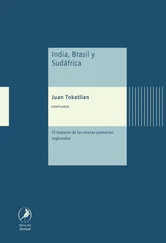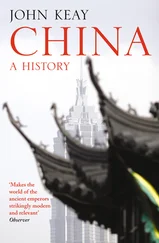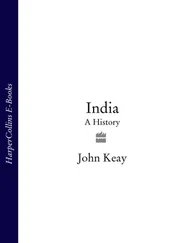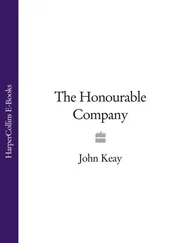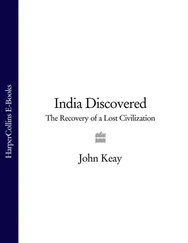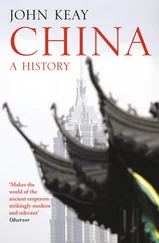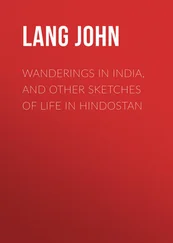One wonders, too, about those astronomical casualty figures. Megasthenes describes the Mauryan army as a permanent and professional body, recruited, trained and maintained at state expense, and which scarcely impinged on the agricultural masses. ‘It therefore not unfrequently happens that at the same time, and in the same part of the country, men may be seen drawn up in array of battle, and fighting at the risk of their lives, while other men close at hand are ploughing and digging in perfect security.’ 14But if this was the case, how were so many non-combatants affected by the Kalingan war? Megasthenes actually gives a figure for the Kalingan army. In Chandragupta’s time it was sixty thousand strong. The Mauryan forces were obviously far more numerous but, unless they suffered a disproportionate number of casualties, it is hard to explain how the total of those slain in battle can have come to anything like 100,000.
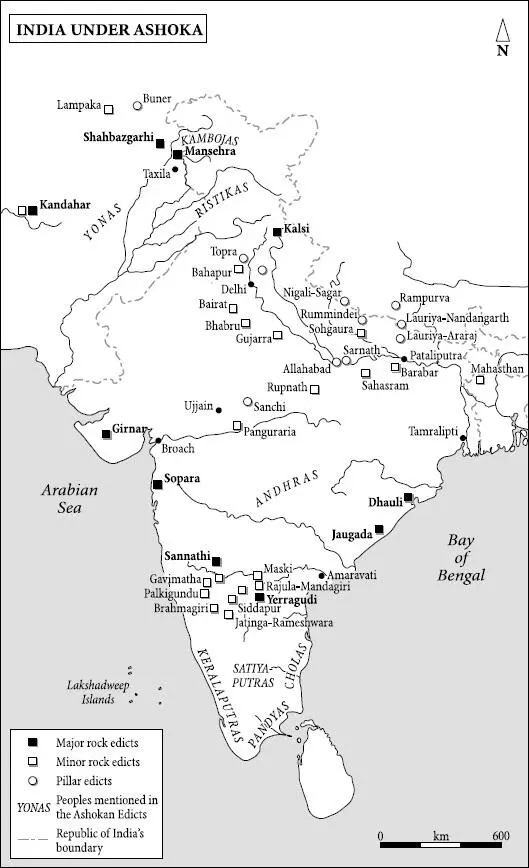
There was nothing unusual, of course, about conflating enemy losses. Perhaps Ashoka exaggerated so as to make his revulsion more plausible. But equally he may, like most victors, have done so principally to magnify his victory and so discourage others from defying his authority. Contrary to popular opinion, he never specifically abjures warfare, nor is there any mention of his disbanding units of the Mauryan army. This is not to say that his remorse was insincere. The Kalinga war had indeed troubled his conscience, and since, according to the Arthasastra , ‘the king encapsulates the constituents of the state,’ his unease seemed to reflect the wider ills of society as a whole. The cure, though, was not the balm of a disastrous pacifism but the bracing tonic of what he called dhamma .
AS LONG AS SUN AND MOON ENDURE
Few rulers have summed up their life’s work in a single word, but that was obviously how Ashoka wanted it. Not for conquests, prosperity or majesty did he wish to be remembered, only for dhamma . To say the word features prominently in his Edicts is an understatement. Nearly all mention it, some many times, and there are several attempts at defining it:
Thus speaks the Beloved of the Gods, the king Piyadassi: There is no gift comparable to the gift of dhamma , the praise of dhamma , the sharing of dhamma , fellowship in dhamma . And this is: good behaviour towards slaves and servants, obedience to mother and father, generosity towards friends, acquaintances and relatives, and towards sramanas and brahmans, and abstention from killing living beings. Father, son, brother, master, friend, acquaintance, relative, and neighbour should say, ‘this is good, this we should do.’ By doing so, there is gain in this world, and in the next there is infinite merit, through the gift of dhamma . [Eleventh Major Rock Edict] 15
Elsewhere dhamma is equated with ‘mercy, charity, truthfulness and purity’. In English it is variously rendered as ‘piety’, ‘duty’, ‘good conduct’ or ‘decency’. Ashoka clearly thought it anything but anodyne, and practised it, preached it, and legislated for it with missionary zeal. It was a panacea not just for India but for the world – this one and the next. The glad tidings were to be carried beyond his frontiers, even to his fellow rulers in the west. The mention of some of their names – including an Egyptian Ptolemy and an Alexander (of Epirus) – provides vital chronological corroboration.
At home, something like a parallel administration was set up to promote and monitor dhamma ’s dissemination. The Edicts embodying it were promulgated, proclaimed, and then encapsulated for all time by that laborious process of gouging them into the very bedrock of India. ‘I have done this,’ Ashoka announced when, after twenty-seven years on the throne, he issued his last Edict, ‘so that among my sons and great grandsons, and as long as the sun and moon shall endure, men may follow dhamma ’ [Seventh Pillar Edict]. 16
It is the tone as much as the content which sends a shiver down awe-struck spines. Ashoka is not just India’s first defined historical personality but, rarer still for such a remote age, he is an intelligible personality. Quite probably the Beloved of the Gods did indeed speak just thus. The language is personal and intimate, not stilted or formalised as is more usual with official directives, and neither condensed for the purposes of inscription nor artfully organised for easy memorising. Occasionally repetitive, it slips from third person to first and from direct speech to indirect, just as one might expect of something dictated and recorded verbatim.
Almost certainly the Edicts first circulated as palm-leaf texts and were then engraved. Literacy not being a widespread skill in the third century BC, they were meant to be read out aloud to the people. At Shahbazgarhi near Peshawar on the edge of the badlands of the north-west frontier, and at Mansehra in the Himalayan foothills north of Taxila, they were written in Kharosthi, the local script derived from Aramaic in Achaemenid times. Further west beyond the Khyber Pass and at Kandahar in the deserts of southern Afghanistan a shortened Edict is in Aramaic with a translation into Greek; had it been discovered earlier, it could, like a Rosetta Stone, have made Prinsep’s task redundant. Although the many inscriptions found deep in the Deccan betray no knowledge of Tamil, elsewhere the adoption of local scripts and languages shows Ashoka appealing directly not only to his own people but to other peoples beyond his frontiers, and to other generations beyond his times. It is this above all, the directness of his directives, which, transcending the millennia, gives them even now such awesome immediacy.
But if the tone is still arresting, one can hardly say the same for the contents. Why, one wonders, lavish so much love, labour and authority on a set of fairly obvious humanitarian injunctions? Assuming they had no political relevance, many historians have portrayed Ashoka more as a religious reformer, another Buddha or Christ, than as an empire-builder. In religious terms his clear preference, as shown in a number of minor inscriptions, was for the Buddhist community; given ‘the rank growth of legend which has clustered round the name of Ashoka’ in Buddhist tradition, dhamma has often actually been equated with Buddhism. This link appears to be borne out by dhamma ’s emphasis on non-violence, on preserving life in all its forms, and on ‘right conduct’ towards one’s fellow human beings. The Third Buddhist Council is supposed to have met under Ashoka’s patronage at Pataliputra. At least one of his dhamma agents, his son Mahinda, was more missionary than emissary. And Ashoka, instead of combining tours of his kingdom with the traditional pastime of a royal hunt, insists that his peregrinations were enlivened only by pilgrimage. Just such a tour, embracing the Buddha’s birthplace and the site of his parinirvana , is commemorated in a series of pillars erected in situ and dated to the twentieth year of his reign, so 248 BC.
However, the tradition that Ashoka actually became a Buddhist monk is now discredited. The inscriptions never mention the Buddha and show no awareness of his ‘Noble Eightfold Path’ or any other Buddhist schema. Even the idea of ‘conversion’ is suspect, since codes like those of the Buddhists and Jains were not seen as exclusive. Religion as creed, doctrine as dogma, and faith as truth are equations with little validity in pre-Islamic India. Most subscribed to the inexorable cycle of rebirth and to the notion that there were various ways of effecting eventual escape from it. The propitiation of a particular deity could help, but was more commonly a means of warding off disease and pestilence. Even brahmanical orthodoxy demanded no profession of faith, merely an acceptance of brahman authority and a high degree of caste conformity. There was indeed competition, especially amongst the heterodox sects, for adherents and for patronage. There was also ferocious debate which, on at least one occasion, required Ashoka’s intervention. But conversion, in the sense of renouncing one set of doctrines for another, was meaningless.
Читать дальше



